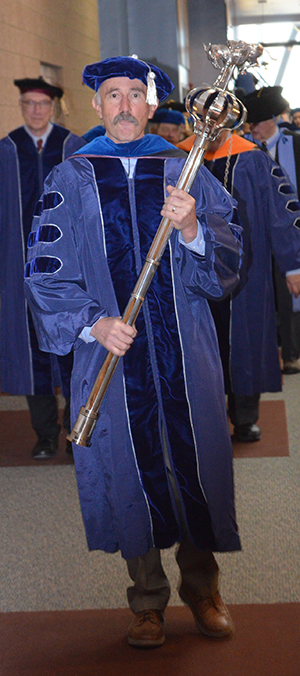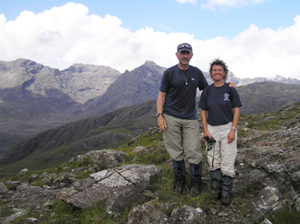2013 Distinguished Lecture Series: Richard Wendlandt
The Culture of Athletics at Mines: A Faculty Member’s Perspective
March 26, 2014, 4 p.m. | Metals Hall, Green Center
 Abstract
Abstract
 Intercollegiate sports competitions were initiated and controlled by students starting in the mid-1800’s but rapidly became tarnished by commercialism, participation by non-student professional athletes and unacceptable numbers of serious injuries and deaths. To restore competitive fairness and safety and to maintain the primacy of academic endeavors over extracurricular activities, the academic faculty assumed control of intercollegiate athletics in the 1870’s and maintained full authority (including conference leadership, passing legislation, enforcing regulations by imposing penalties, etc.) until the 1920’s. But faculty leadership failed to transform athletics into a partnership with the academic mission and growing faculty indifference to athletics and refusal to acknowledge the educational value of athletics led to loss of control.
Intercollegiate sports competitions were initiated and controlled by students starting in the mid-1800’s but rapidly became tarnished by commercialism, participation by non-student professional athletes and unacceptable numbers of serious injuries and deaths. To restore competitive fairness and safety and to maintain the primacy of academic endeavors over extracurricular activities, the academic faculty assumed control of intercollegiate athletics in the 1870’s and maintained full authority (including conference leadership, passing legislation, enforcing regulations by imposing penalties, etc.) until the 1920’s. But faculty leadership failed to transform athletics into a partnership with the academic mission and growing faculty indifference to athletics and refusal to acknowledge the educational value of athletics led to loss of control.
While governance of athletic programs has changed hands several times over the past 90 years, the academic faculty remain involved, typically in an advisory capacity. Not surprisingly, the same disruptive influences that existed in the mid-1800’s, along with revenue inequality and financial unsustainability, are present today in some levels of intercollegiate athletics. Now, as in the past, faculty oversight of institutional sports and athletics programs, advocacy for the academic mission and a balanced partnership between academics and athletics is essential.
An institution’s Faculty Athletics Representative plays a pivotal role in maintaining this balance. The FAR is charged with ensuring the athletics program is an integral part of the educational program and student-athletes are integral parts of the student body. The FAR promotes understanding of the relationship between intercollegiate athletics and the overall institutional goals of: •Ensuring academic integrity of the athletics program; •Ensuring institutional control of the athletics program; and •Ensuring student-athlete quality of life.
In this talk, I will review the position and function of the FAR and describe the important role that academic faculty have in oversight of intercollegiate athletics. I will evaluate the institutional goals noted above as they currently exist at Mines and provide a perspective on the academic life of the student-athlete at Mines: This perspective will begin with the recruitment, academic preparedness, and admission of student-athletes to Mines and follow with a discussion of their subsequent academic performance and the challenges of balancing the opposing/conflicting demands of academics and athletics. Lastly, I will make some observations on costs/benefits of being an intercollegiate student-athlete at Mines.
 Biography
Biography
 Richard Wendlandt is a professor in the Department of Geology and Geological Engineering at Mines. Ric received a BA from Dartmouth College in 1973 and then attended The Pennsylvania State University where he completed his PhD in Geochemistry and Mineralogy in 1978. Along the way, Ric spent two years from 1976-1978 as a pre-doctoral fellow at the Geophysical Laboratory, one of the five original research departments of the Carnegie Institution of Washington. Ric’s research activities during this time were primarily in the realm of experimental petrology applied to the origins of igneous rocks. Following a 1-year NASA funded post- doctoral fellowship at the U.S. Geological Survey, Branch of Experimental Geochemistry/Mineralogy in Reston, Va., where he conducted experimental investigations applied to planetary core segregation, he spent three years as a researcher and staff scientist at the Lunar and Planetary Institute in Houston, Texas. Ric’s research at LPI focused on the effects of water, carbon dioxide, and sulfur on igneous rock origins and associations of alkaline magmas with continental rift structure, evolution, and tectonics. From 1982 to 1987, Ric was a senior research geologist and research specialist at (then) Exxon Production Research Company in Houston, where he conducted petrophysics research dealing with the effects of clay minerals on rock and fluid properties and well log response. Ric arrived at Mines in 1987, was tenured and promoted to associate professor in 1991 and promoted to professor in 1997.
Richard Wendlandt is a professor in the Department of Geology and Geological Engineering at Mines. Ric received a BA from Dartmouth College in 1973 and then attended The Pennsylvania State University where he completed his PhD in Geochemistry and Mineralogy in 1978. Along the way, Ric spent two years from 1976-1978 as a pre-doctoral fellow at the Geophysical Laboratory, one of the five original research departments of the Carnegie Institution of Washington. Ric’s research activities during this time were primarily in the realm of experimental petrology applied to the origins of igneous rocks. Following a 1-year NASA funded post- doctoral fellowship at the U.S. Geological Survey, Branch of Experimental Geochemistry/Mineralogy in Reston, Va., where he conducted experimental investigations applied to planetary core segregation, he spent three years as a researcher and staff scientist at the Lunar and Planetary Institute in Houston, Texas. Ric’s research at LPI focused on the effects of water, carbon dioxide, and sulfur on igneous rock origins and associations of alkaline magmas with continental rift structure, evolution, and tectonics. From 1982 to 1987, Ric was a senior research geologist and research specialist at (then) Exxon Production Research Company in Houston, where he conducted petrophysics research dealing with the effects of clay minerals on rock and fluid properties and well log response. Ric arrived at Mines in 1987, was tenured and promoted to associate professor in 1991 and promoted to professor in 1997.
Ric’s research activities at Mines have continued his early interests in igneous petrology and the relationships of igneous occurrences with continental rifting processes while expanding into studies of igneous rock-hosted mineral deposits, integration of experimental and numerical simulations of fluid-rock interactions, and environmental and applied mineralogy. In 2004 he took a sabbatical at the University of Manchester, UK, and the Daresbury Synchrotron Radiation Source where he conducted research on surface properties of minerals, including respirable silica and arsenic adsorption on bovine bone. Recent research activities include studies on geochemistry of geothermal systems in Colorado and Alaska, carbon dioxide mineral sequestration, and igneous rock-hosted REE mineralization. He has advised or co-advised 30 graduate students through degree completion, including 10 PhD’s.
While at Mines, Ric has taught 11 different undergraduate and seven different graduate courses and 12 graduate-level seminars on assorted topics. His courses in mineralogy and petrology, at both undergraduate and graduate levels, are typically analytically intensive, requiring students to make use of various X-ray diffraction and microscopy techniques. Ric has led frequent student field trips in the Rocky Mountain states, including New Mexico, Wyoming, Montana, Utah and Colorado. In 2005 and 2008, he and Professor Wendy Harrison organized and led undergraduate geology field trips to Scotland. Ric has received the Outstanding Geology Faculty award and in 2006 he was the recipient of the CSM Alumni Teaching Award.
Ric’s service at Mines includes multiple stints on the CSM Faculty Senate and the Senate Executive Committee, participation in the McBride Honors Program Tutorial Committee from 1994-2006 and the McBride Honors Program Executive Committee from 1997-1999 and again from 2001-2002, and chair of the Geochemistry Program on various occasions since the program’s inception in 1993. Ric’s most durable institutional service, however, has centered on faculty oversight of the various Mines athletics programs. Beginning in 1991, he became involved with the Faculty Oversight Committee on Sports and Athletics, serving as a member from 1991-1994, and 1998-2003. Since 2003, he has served as chair of the Faculty Oversight Committee on Sports and Athletics and as the Mines Faculty Athletics Representative. It is this experience that informs todays lecture.
Ric’s family includes his wife, Mines Professor Wendy Harrison, whom he met while both were graduate student fellows at the Geophysical Laboratory, and two adult children, Piers, who graduated from Mines in 2005 with a degree in Mining Engineering, and Alison, who is currently finishing a PhD in organic chemistry at the University of Wisconsin.